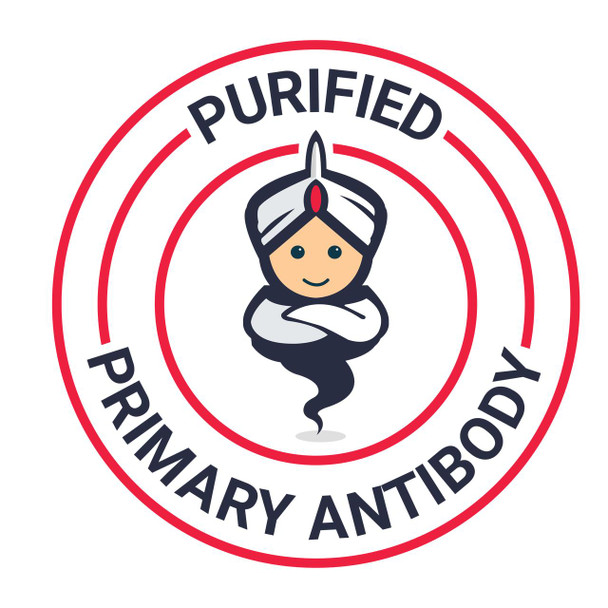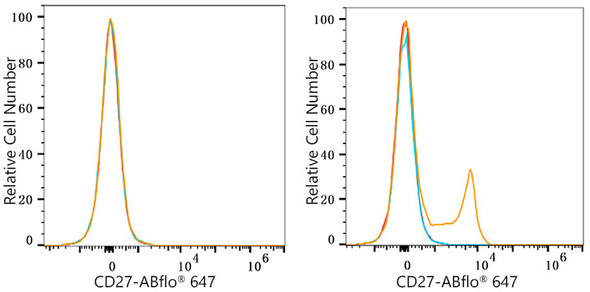Description
system_update_altDatasheet
| Product Name: | CD27 monoclonal antibody (PE) |
| Product Code: | AGIM0354 |
| Size: | 100 µL |
| Reactivity: | Human |
| Clone: | LT27 |
| Applications: | Flow Cytometry |
| Conjugate: | PE |
| Isotype: | IgG2a |
| Host Species: | Mouse |
| Storage: | Store at 4°C. Avoid prolonged exposure to light. |
| Uniprot: | P26842 |
| Background: | CD27 is a transmembrane 55 kDa protein of the nerve growth factor-receptor family, expressed as a disulfide-linked homodimer on mature thymocytes, peripheral blood T cells and a subpopulation of B cells. Activation of T cells via TCR-CD3 complex results in upregulation of CD27 expression on the plasma membrane as well as in the release of its soluble 28-32 kDa form, sCD27, detected in the plasma, urine or spinal fluid. This sCD27 is an important pronostic marker of acute and chronic B cell malignamcies. RgpA, a cystein proteinase, although activating T cells through the protease-activated receptors (PARs), degradates CD27 and counteracts T cell activation mediated by CD27 and ist ligand CD70. |
| UniProt Protein Function: | CD27: Receptor for CD70/CD27L. May play a role in survival of activated T-cells. May play a role in apoptosis through association with SIVA1. |
| UniProt Protein Details: | Protein type:Membrane protein, integral; Apoptosis; Receptor, cytokine Chromosomal Location of Human Ortholog: 12p13 Cellular Component: integral to plasma membrane; neuron projection; nucleus; plasma membrane Molecular Function:caspase inhibitor activity; protein binding; tumor necrosis factor receptor activity Biological Process: brain development; immune response; induction of apoptosis via death domain receptors; inflammatory response; negative regulation of apoptosis; positive regulation of JNK cascade; positive regulation of MAPKKK cascade; regulation of cell proliferation; response to lipopolysaccharide; tumor necrosis factor-mediated signaling pathway Disease: Lymphoproliferative Syndrome 2 |
| NCBI Summary: | The protein encoded by this gene is a member of the TNF-receptor superfamily. This receptor is required for generation and long-term maintenance of T cell immunity. It binds to ligand CD70, and plays a key role in regulating B-cell activation and immunoglobulin synthesis. This receptor transduces signals that lead to the activation of NF-kappaB and MAPK8/JNK. Adaptor proteins TRAF2 and TRAF5 have been shown to mediate the signaling process of this receptor. CD27-binding protein (SIVA), a proapoptotic protein, can bind to this receptor and is thought to play an important role in the apoptosis induced by this receptor. [provided by RefSeq, Jul 2008] |
| UniProt Code: | P26842 |
| NCBI GenInfo Identifier: | 269849546 |
| NCBI Gene ID: | 939 |
| NCBI Accession: | P26842.2 |
| UniProt Secondary Accession: | P26842,B2RDZ0, |
| UniProt Related Accession: | P26842 |
| Molecular Weight: | 29,137 Da |
| NCBI Full Name: | CD27 antigen |
| NCBI Synonym Full Names: | CD27 molecule |
| NCBI Official Symbol: | CD27 |
| NCBI Official Synonym Symbols: | T14; S152; Tp55; TNFRSF7; S152. LPFS2 |
| NCBI Protein Information: | CD27 antigen |
| UniProt Protein Name: | CD27 antigen |
| UniProt Synonym Protein Names: | CD27L receptor; T-cell activation antigen CD27; T14; Tumor necrosis factor receptor superfamily member 7; CD_antigen: CD27 |
| Protein Family: | CD27 antigen |
| UniProt Gene Name: | CD27 |
| UniProt Entry Name: | CD27_HUMAN |



 Human CD27 Monoclonal Antibody (PE Conjugated) [O323](AGEL1707)](https://cdn11.bigcommerce.com/s-rd6ounxcu2/images/stencil/590x590/products/12652/16704/human-cd27-monoclonal-antibody-pe-conjugated-o323agel1707__45029__84352.1706270098.jpg?c=1)
 Human CD27 Monoclonal Antibody (PE/Cyanine7 Conjugated) [O323](AGEL1711)](https://cdn11.bigcommerce.com/s-rd6ounxcu2/images/stencil/590x590/products/12655/16707/human-cd27-monoclonal-antibody-pecyanine7-conjugated-o323agel1711__14404__42476.1706270099.jpg?c=1)
 Human CD27 Monoclonal Antibody (PE/Cyanine5.5 Conjugated) [O323](AGEL1712)](https://cdn11.bigcommerce.com/s-rd6ounxcu2/images/stencil/590x590/products/12656/16708/human-cd27-monoclonal-antibody-pecyanine5.5-conjugated-o323agel1712__33612__93713.1706270100.jpg?c=1)
 Human CD27 Monoclonal Antibody (PE/Cyanine5 Conjugated) [O323](AGEL1710)](https://cdn11.bigcommerce.com/s-rd6ounxcu2/images/stencil/590x590/products/12654/16706/human-cd27-monoclonal-antibody-pecyanine5-conjugated-o323agel1710__62221__12362.1706270099.jpg?c=1)